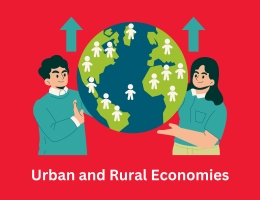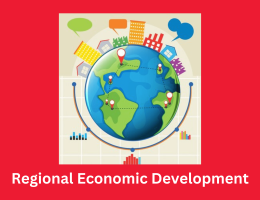
Policies for regional development that encourage catching up
- By admin --
- Wednesday, 01 May, 2024
Introduction
The nearby improvement coverage approach that turned into addressed by means of the OECD's Regional Development Policy Committee has been implemented by way of OECD international locations over the past fifteen years. Nonetheless, depending on the functions of the place, a number of structural and sectoral guidelines have a full-size and sundry have an effect on. While positive policy techniques can be carried out continuously all through a nation, extra customized answers are necessary because of the particular situations that exist in each remote rural areas and massive city centers, in addition to the many gaps in between. In order to obtain the desires of boom and nicely-being, national techniques for local, urban, and rural improvement paintings in concert with different countrywide degree programs. Since subnational governments oversee fifty nine% of all public funding, the efficacy of guidelines concerning local improvement is contingent upon the ability of various governmental stages to collaborate successfully. This chapter concentrates on policies that governments have officially designated as vicinity-based regulations, aimed at both city and rural regions especially in addition to areas in preferred.
One technique for governance is countrywide networks of nearby improvement groups.
One governance instrument that nations have utilized to devise the execution of rules aimed at certain areas is the introduction of regional improvement companies (RDAs). Several forms of RDAs are regularly occurring in OECD nations. An agency version theoretically shows separateness and normally stricter standards for overall performance duty. There are great differences between the varieties of vital or local authorities, as well as public-personal forums, because the important to which the company reports. The majority of OECD countries have locally administered RDAs, and there is a tendency closer to greater specialization in a single or greater precise areas, most extensively employer development and/or innovation. Despite being immediately answerable to a region, RDAs continue to be a part of a complex governance structure that encompasses numerous degrees of government. According to a European assessment, forty percentage of the RDAs assessed received financial aid from governments outdoor of the area (Halkier, 2011). To resource in nearby improvement, some countries have hooked up RDA networks on the national degree. A variety of alternatives for addressing governance problems are layered across the decision on primary authorities action.
Building regional capability in a framework of a centrally deliberate state turned into the riding force for the established order of country wide RDA networks in the majority of OECD nations. The EU accession technique, particularly for Eastern European international locations like Hungary, has been the driving pressure at the back of the status quo of RDAs or similar businesses in numerous OECD countries. These countrywide networks of regional agencies are being set up with the intention of mapping to statistical regions eligible to get hold of funding for EU nearby coverage. Among different things, Turkey's country wide model evolved due to EU involvement with the country. The introduction of Chile's country wide network of fifteen RDAs become in part funded by the Inter-American Development Bank. Although Hungary has opted to re-centralize its network, in some of those instances the crucial government has steadily tried to embed these corporations within the areas for a deeper feeling of nearby possession.
The creation of country wide RDAs to help in coordinating countrywide initiatives for regional development in a country that is already decentralized is a chunk much less conventional. Canada is one such instance of an exception. Regarding debt, funding, and public spending, it's far the OECD country with the maximum decentralized authorities. Moreover, neighborhood and regional development groups from each province and municipality coexist alongside the country wide network. RDAs had been applied, in the meantime, to shift federal pastime in the course of a greater regionalized approach. With six places at some stage in the state, the Economic Development Administration's nearby places of work within the United States serve areas similar to those in Canada. However, they may be nearby offices of a countrywide branch (minister) rather than groups in and of themselves. Additionally, certain areas inside the US are special for national area-based assistance; these places, like the Appalachia Regional Commission, perform similarly to corporations and generally embody portions or the whole thing of several US states.
The way that the intermediate stage regions' multi-stage governance surroundings is developing has sparked questions concerning rural regions' illustration in subnational governance. The feature of those intermediate-stage areas has been questioned due to diverse evolutions in merging or municipal recomposition (up-scaling), inter-municipal cooperation (trans-scaling), and metropolisation (Chatry and Hulbert, impending). This stage of governance is being discussed by means of some of administrations, inclusive of the ones in Italy, France, Belgium, and Poland, or it became lately eliminated (Council of Europe, 2013). In a few US states, counties had been abolished or merged with towns. Certain town-county mergers in Turkey involve province-huge rural regions. The electricity dynamics inside the surviving higher stage nearby layer are the various issues raised by using the removal of these intermediary degrees. At this higher size of elected administration, rural communities—which had greater political impact at the smaller intermediate level—need to now voice their worries along the ones of extra populated metropolitan areas.
Conclusion
The OECD international locations shifted their local policy techniques to concentrate on productiveness over numerous a long time. These rules are increasingly being directed toward enhancing each countrywide boom and nearby overall performance, however with an eye closer to balanced boom that lessens interregional inequities. In many nations, the equipment used to perform these targets also are transferring faraway from services which can be subsidized or fundamental infrastructure and towards offerings a good way to growth commercial enterprise efficiency. This shift has been accelerated in several EU member states by using EU rules. The query of whether those measures are enough to guarantee that the productivity upward thrust in the ones pinnacle businesses is, in reality, supporting the relaxation of the economic system, across all areas, is raised by way of the prevailing traits in global productiveness. To similarly recognize the factors driving innovation dispersion and the coverage contraptions most beneficial in encouraging nearby catch-up, more have a look at is needed.





